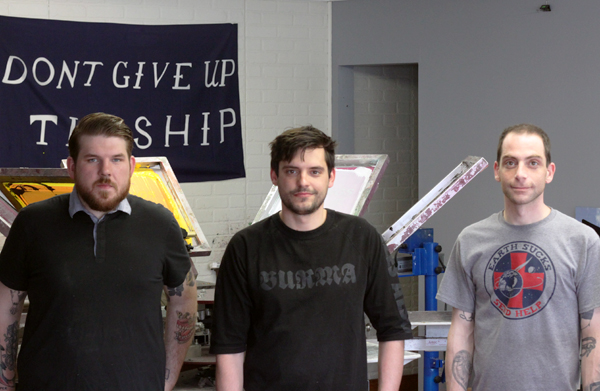
Traditional technology presses on in Antilogy, a T-shirt printing shop tucked away on Main Street. In late afternoon, the ceased hum of the conveyor dryer signals that work is finished — for now.
When he was 16, Jim Moore began printing. The hobby grew slowly — he first printed T-shirts for friends and local bands in his Vermont hometown. When he worked at another shop, he brought in jobs. Eventually, he opened up Antilogy.
Moore, who has lived in New Paltz for 15 years, opened Antilogy in New Paltz in June 2010. Antilogy’s former Rosendale location had been open since 2006.
Ryan Williams, Antilogy’s graphic designer, has worked with Moore for seven years. He originally intended to visit only for a weekend, but ended up extending his stay.
Williams also frequently designs for the burrito chain Blockheads, Active Ride Shop and Rock and Snow, one of Antilogy’s rare local customers. Moore draws the “bare bones” of a design, and once the customer is satisfied, works 16-hour days to hand-draw the piece so that it can be transferred to a T-shirt. Sharpening and finishing is usually done on the computer, which Williams said he doesn’t like to rely on.
“I don’t have big lofty art,” Williams said. “You can’t have grandiose ideas. T-shirts make you whittle down what you want to say.”
The staff at Antilogy doesn’t seem to worry about competition. Unlike other printing shops in the New Paltz area, the majority of Antilogy’s customers are from outside the Hudson Valley.
Word of mouth, Moore said, is key. Antilogy ships about a thousand shirts per week and gets its customers from online message board sites. Clients also follow Williams’ work. And although Antilogy primarily prints to supply skatewear and streetwear companies, customers order from all over the country.
“From a climbing company in [Philadelphia]…to a band in Portland. It’s all different every week,” Moore said. “It’s a traditional way to do business in a modern world.”
Matt Luczak recently finished his first month working at Antilogy and said the staff’s shared interests, like skateboarding and local bands, help to produce a welcoming work environment.
“It’s chill, it’s not about competition,” Luczak said. “It’s about doing your personal best, having high standards. It makes it interesting if you’re going to be printing all day.”
Moore uses a darkroom and exposed screens to print up to six colors at a time.
“It’s about tricking your eye. For instance [on a Metallica shirt], there are only four colors: cyan, magenta, yellow and black,” he said. “The way they overlap, the colors stack up. With the blue directly on the shirt, it looks metallic. It’s an antiquated process.”
Antilogy has two presses, one used for single color prints and one for multiple colors, Moore said.
The screen is lowered onto a shirt and wiped over with a squeegee. Moore uses pressure to apply the color and prints colors in rounds.
If the shirt’s colors are solids, he said he waits until the color has dried before continuing, but for gradient prints, he adds another color with the squeegee while the paint is freshly wet, varying the pressure. He finishes the process when the shirts run through the conveyor dryer to set.
“At least once a week there’s a job I’m pretty psyched about,” Moore said. “I’d be buying the shirt if I wasn’t making it.”

